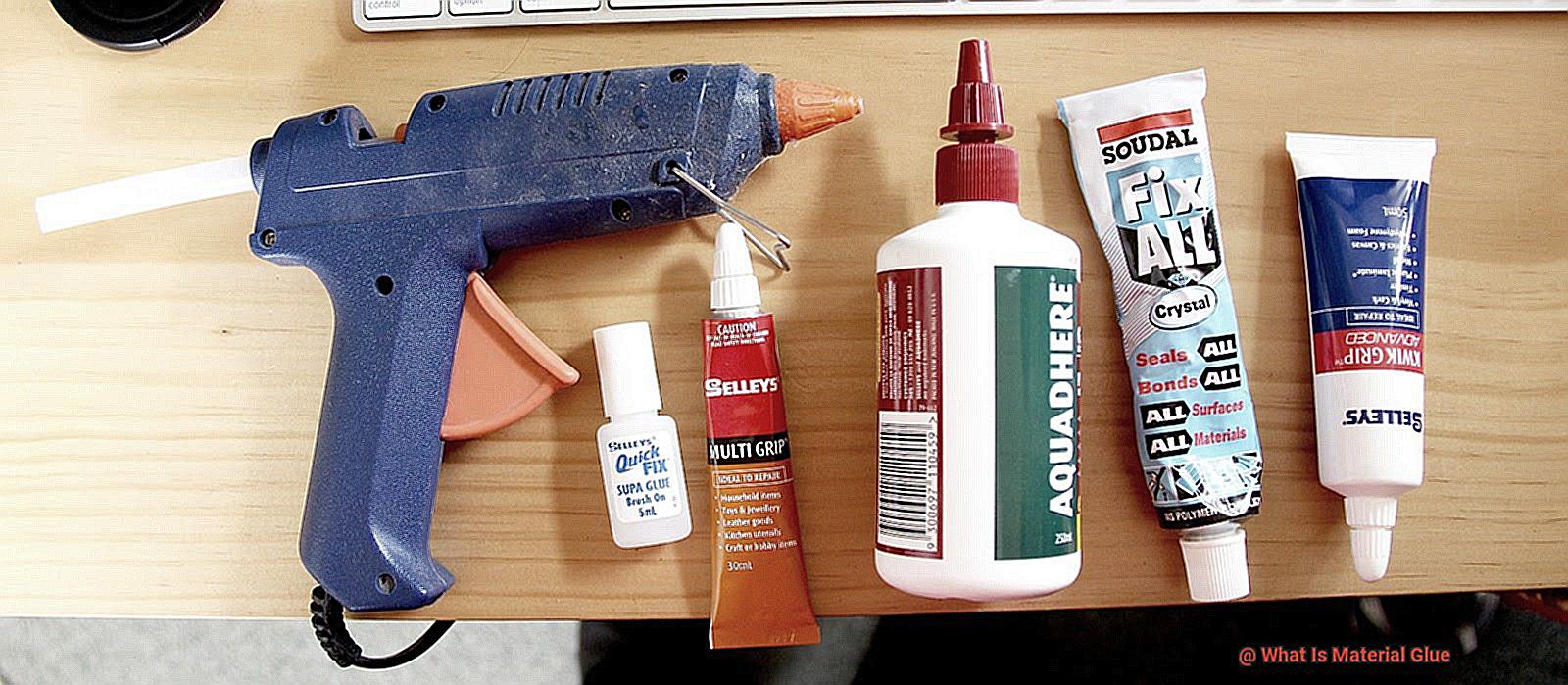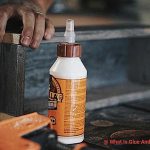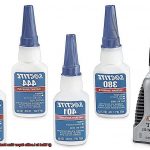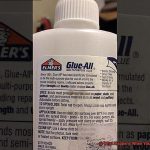Ever wished you could effortlessly join fabrics, leathers, or even plastics together with a wave of your hand? Prepare to be amazed as we delve into the captivating realm of material glue. This unassuming adhesive holds incredible power, captivating professionals and hobbyists alike.
Picture yourself easily fixing torn upholstery, crafting stunning creations, or even designing your own clothes with just a touch of this enchanting elixir. Material glue, also known as fabric adhesive, is a versatile solution that combines convenience and strength, making it an essential tool for any DIY enthusiast.
Whether you’re a seasoned seamstress chasing seamless finishes or a newbie crafter ready to embark on creative adventures, material glue offers endless possibilities. From clothing to accessories, household repairs to artistic endeavors – this adhesive opens doors you never knew existed.
Professionals like tailors and designers rely on material glue to speed up their work and achieve flawless results. Meanwhile, casual crafters and hobbyists find this adhesive equally invaluable for transforming everyday objects into extraordinary pieces that breathe life into their projects.
The secret behind material glue lies in its special formula designed to create powerful bonds between various materials. With options like washable fabric glue, heat-activated adhesives, or specialty craft glues, you can create sturdy connections that withstand the test of time – even under extreme pressure.
And let’s not forget about the convenience factor. Say goodbye to needles, thread tangles, and pricked fingers. Material glue provides a clean alternative that saves time and effort without compromising quality.
In the upcoming sections of this blog series, we’ll explore the diverse applications of material glue along with helpful tips and tricks. Get ready to learn dos and don’ts while uncovering the vast potential at your fingertips.
So whether you’re a professional seeking an edge in your industry or simply a creative soul eager to dive into the world of DIY, material glue is your ultimate secret weapon for adhesive needs. Stay tuned as we reveal the enchanting properties and applications of this magical elixir, empowering you to create and repair with finesse. The journey awaits.
Types of Material Glue
Contents
- 1 Types of Material Glue
- 2 How Does Material Glue Work?
- 3 Properties of Different Types of Glue
- 4 Choosing the Right Type of Glue for Your Project
- 5 Application and Safety Considerations
- 6 Surface Preparation for Better Bonding Results
- 7 Enhancing the Bonding Process with Additional Tools or Techniques
- 8 Advantages and Limitations of Material Glue
- 9 Conclusion
Material glue is a versatile and essential tool for various projects, from DIY crafts to industrial applications. With so many options available in the market, it can be overwhelming to choose the right adhesive for specific materials. In this comprehensive guide, we’ll explore the different types of material glue and their unique characteristics and uses.
Wood Glue:
Wood glue is specifically formulated to bond wood surfaces together. It provides a strong and durable bond, making it ideal for woodworking projects, furniture repairs, and carpentry tasks. Wood glue comes in various forms such as yellow glue, white glue, and polyurethane glue. Yellow glue is water-based and dries clear, offering strong adhesion for general woodworking. White glue is also water-based but has a longer drying time, making it suitable for projects that require precision and adjustment. Polyurethane glue expands as it cures, creating a strong bond that is resistant to water and heat.
Fabric Glue:
Fabric glue is designed for bonding fabrics together without the need for stitching. It is perfect for sewing or crafting projects where traditional stitching may not be suitable, such as attaching patches or embellishments. Fabric glue is easy to use and dries clear, ensuring a seamless bond that withstands washing and wear. Some fabric glues are also flexible when dry, allowing fabrics to maintain their natural movement without stiffness or cracking.
Metal Glue:
Metal glue is specially formulated to bond metal surfaces securely. It is commonly used in automotive or industrial applications where metal parts need to be joined effectively. Epoxy adhesives and industrial-strength glues are popular choices for metal bonding due to their ability to withstand high temperatures and provide a strong bond. These glues typically require surface preparation such as roughening or cleaning the metal before application to ensure maximum adhesion.
Plastic Glue:
Plastic glue is essential for bonding plastic materials, but it’s crucial to choose the right type depending on the specific plastic being bonded. Cyanoacrylate glue (super glue), epoxy resin adhesive, and polyurethane adhesive are common options for plastic bonding. Cyanoacrylate glue forms an instant bond and is suitable for small repairs and bonding rigid plastics. Epoxy resin adhesive provides a strong bond and is ideal for bonding different types of plastics together. Polyurethane adhesive is flexible when dry, making it suitable for bonding flexible or porous plastics.
Specialized Glues:
Apart from wood, fabric, metal, and plastic glues, there are also specialized glues available for other materials. Ceramic, glass, leather, and paper glues are formulated to provide strong adhesion for specific materials. Ceramic glue is heat-resistant and waterproof, making it ideal for repairing ceramic or porcelain objects. Glass glue is designed to bond glass surfaces quickly and effectively with the help of ultraviolet light.
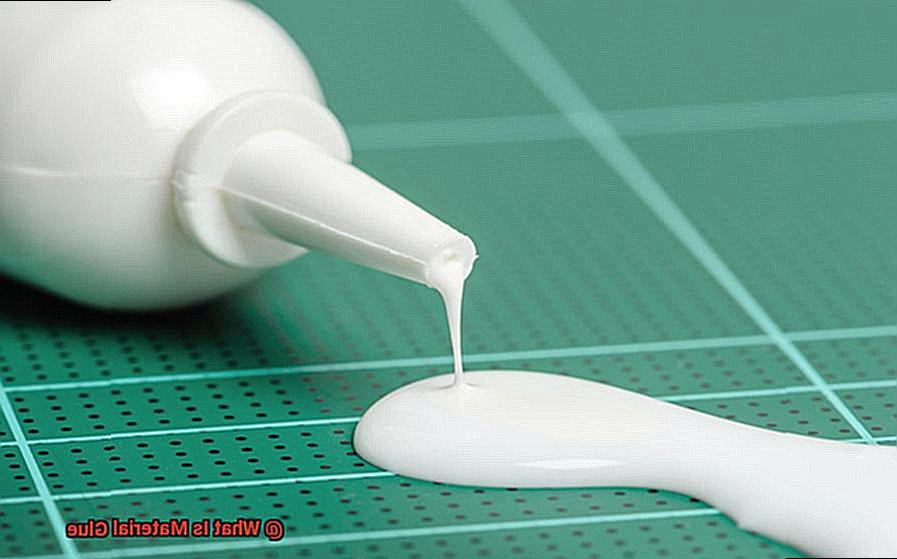
How Does Material Glue Work?
Material glue is the unsung hero of the crafting and construction world, holding everything together with its adhesive properties. But have you ever wondered how material glue actually works? Let’s delve into the fascinating world of material glue and its various types.
- Solvent-based glue: This common type of glue contains volatile organic compounds (VOCs) that evaporate when exposed to air. As the solvent evaporates, it causes the glue to harden and create a bond between materials. Solvent-based glues are known for their quick drying time and strong bonding capabilities, making them ideal for woodworking or general repairs.
- Water-based glue: For a non-toxic option, water-based glue is the way to go. Water serves as the main solvent in this type of glue. As it slowly evaporates, the glue penetrates the materials, creating a strong bond as it dries. Water-based glues are easy to use and perfect for projects involving paper, fabric, or lightweight materials.
- Epoxy glues: These glues consist of two components that must be mixed before application. When mixed, the epoxy begins a chemical reaction that results in an incredibly strong and durable bond. Epoxy glues are widely used in industries where strength and durability are crucial, such as automotive and aerospace.
- Hot melt glues: Solid at room temperature, hot melt glues melt when heated and solidify as they cool down. Applied in molten form, they create a bond between materials upon cooling. Hot melt glues are versatile and commonly used in arts and crafts projects.
Regardless of the type of material glue used, proper surface preparation is key to achieving a strong bond. Surfaces should be clean, dry, and free from dust or grease that could interfere with adhesion. Additionally, selecting the right glue for specific materials is essential as different glues are designed to work with specific materials.
Properties of Different Types of Glue
Get ready to embark on a thrilling journey into the enchanting world of glue. In this exploration, we will uncover the unique properties and characteristics of different types of glue. From quick-dry wonders to flexible glues, let’s dive in and discover the magical powers that lie within these adhesive wonders.
Quick-Dry Marvels:
When time is of the essence, quick-dry glues swoop in like superheroes, saving the day. These remarkable glues dry faster than a speeding bullet, allowing you to complete your projects in record time. Perfect for those impatient crafters and artists, quick-dry glues provide a strong bond that holds tight. Whether you’re fixing a broken toy or creating a masterpiece, these speedy heroes are here to save the day.
Mighty Bonding Strength:
Strength is the name of the game when it comes to bonding materials together. Some glues were born to conquer heavy-duty tasks like true superheroes. They create an unbreakable bond that can withstand even the toughest challenges. Ideal for repairing furniture or building intricate models, these glues act as mighty fortresses, keeping everything securely in place.
Flexible Allies:
For projects that require a little wiggle room, flexible glues step up as the true MVPs. They don’t crack under pressure, quite literally. These magical potions retain their flexibility even after drying, making them perfect for bonding fabrics or bendy plastics. So go ahead and create those stretchy headbands or fix that favorite pair of yoga pants – flexible glue has got your back.
Adhesive Warriors:
Different surfaces require different glue powers. Enter the adhesive warriors – glues with incredible adhesive strength. These champions can bond to almost anything, from metal to plastic to glass. With them by your side, you can conquer any DIY project or repair job that comes your way. So unleash your imagination and let the adhesive warriors guide you to victory.
Heat-Defying Heroes:
Some glues can handle the heat, while others melt under pressure. Fear not, for the heat-defying heroes are here to save the day. These remarkable glues can withstand high temperatures without losing their bond strength. They’re perfect for projects involving hot objects or outdoor applications. So whether you’re crafting a sizzling summer wreath or fixing your favorite mug, these heat-defying heroes have got you covered.
Choosing the Right Type of Glue for Your Project
Today, we embark on a journey through the captivating world of selecting the perfect glue for your project. Whether you’re a crafty DIYer or a professional in need of a reliable adhesive, understanding the key factors to consider will ensure a bond as strong as your enthusiasm.
First and foremost, let’s talk materials. Different glues are designed to adhere to specific surfaces, so it’s crucial to choose one that matches your project’s materials. If you’re working with porous materials like wood or fabric, opt for a glue that can seep into those tiny openings and create a secure bond. On the other hand, if you’re dealing with non-porous materials such as glass or metal, you’ll need an adhesive specifically formulated for those surfaces.
Next up is the strength of the bond required. Are you looking for a temporary fix or a permanent connection? A glue stick or double-sided tape might be suitable for craft projects that may need disassembly later. However, when repairing ceramics or other fragile items, reach for the big guns like epoxy or super glue to ensure a rock-solid bond.
Consider the environment in which your project will live. Temperature and moisture can impact certain types of glue. For instance, if your artwork will bask under the scorching sun or brave high humidity levels, make sure to choose a glue that won’t lose its grip under these conditions.
Safety first. Some glues emit strong fumes or contain toxic chemicals, so it’s vital to work in a well-ventilated area or use protective gear if necessary. If kids are involved in your project, opt for non-toxic glues that are safe for their little hands.
Lastly, let’s talk application methods. Glues come in various forms: liquid, gel, spray, or stick. Each method has its own advantages and disadvantages depending on the project requirements. Consider the ease of use and precision necessary for your specific task.
Application and Safety Considerations
This versatile adhesive possesses extraordinary abilities, allowing it to unite diverse materials like wood, metal, plastic, and fabric. But before embarking on your next project, let’s delve into the fascinating realm of application and safety considerations. By mastering these crucial aspects, you can achieve flawless bonds while safeguarding yourself.
Mastering the Application Process:
Glue application is an art form that demands precision and meticulousness. Each type of glue requires a distinct approach. Liquid glues gracefully flow onto surfaces, guided by brushes or nozzles, while solid glues demand the embrace of heat or pressure for activation.
However, regardless of the glue’s form, cleanliness reigns supreme. Prepare your surfaces diligently, banishing dust, oil, or any unwelcome contaminants. This ritual lays the foundation for a robust bond and shields you from potential mishaps.
Dos and Don’ts:
Unlocking the secrets of the perfect bond hinges on obeying the wisdom bestowed by glue manufacturers. Their sacred instructions hold the key to bonding glory. Beware. An excessive application can lead to unruly messes and prolonged drying periods. Conversely, skimpy glue usage may result in weak bonds. Therefore, heed those labels meticulously and apply the recommended amount for optimal outcomes.
Safety First:
In this realm of adhesive wonders, safety must never be an afterthought. As you embark on your glue-infused journey, don your armor of gloves. These guardians shield your skin from direct contact with potential adversaries lurking within the adhesive. Moreover, ensure your workspace breathes freely in a well-ventilated environment. Beware. Some glues emit fumes that may seek harm if inhaled.
Know Your Glue:
Delving deeper into this world reveals a tapestry of glues, each with its unique set of safety considerations. Enter cyanoacrylate glues, the sorcerers commonly known as superglue, capable of binding skin within an instant. Exercise caution, for their touch must be avoided by all means. In case of accidental contact with this potent sorcery, rush to the aid of water and seek medical attention should the need arise.
Storage Matters:
Preserving the potency of your adhesive arsenal and averting accidents necessitates meticulous storage. House your glue in cool and dry sanctuaries, far removed from heat sources and the piercing gaze of sunlight. Furthermore, ensure these treasures remain inaccessible to curious minds and paws, safeguarding against unintended misfortunes.
Surface Preparation for Better Bonding Results
In this guide, we will explore the crucial steps that will take your glue game to new heights. Get ready to dive into surface preparation and unlock the power of adhesion.
Cleanliness is Next to Glue-liness:
Before you even think about applying adhesive, cleanliness is paramount. Dust, dirt, grease, and other contaminants can act as barriers, hindering the adhesive’s ability to bond effectively. To ensure optimal results, use a mild detergent solution or a specialized cleaner to make your surface squeaky clean. Remember, the cleaner the surface, the stronger the bond.
Dry it Out:
Moisture and adhesives are not a match made in heaven. To prevent any unwanted weakening of your adhesive bond, make sure your surface is completely dry before applying glue. Use a clean, lint-free cloth to wipe away any excess moisture or allow sufficient time for air drying. This step will guarantee a strong and long-lasting bond.
Rough it Up:
Sometimes, smooth surfaces need a little rough love to enhance adhesion. Grab your sandpaper or an abrasive material and create microscopic grooves or scratches on the surface. These tiny imperfections provide more area for the adhesive to grip onto, resulting in a stronger and more durable bond.
Material-Specific Treatments:
Different materials have different bonding requirements. Metals may require a primer or an etching solution to improve adhesion, while plastics might benefit from chemical or flame treatments. Always consult the manufacturer’s instructions for specific adhesive products to ensure you’re treating your surfaces correctly. By giving your materials the special treatment they need, you’ll optimize their bonding potential.
Follow Instructions:
Last but not least, follow the instructions. Each adhesive has its own specific requirements for surface preparation. By diligently following the manufacturer’s guidance, you’ll avoid any potential pitfalls and achieve optimal bonding results. Don’t underestimate the power of careful instruction-following in creating unbreakable bonds.
Enhancing the Bonding Process with Additional Tools or Techniques
Are you tired of weak and unreliable bonds when using material glue? Looking for ways to take your adhesive skills to the next level? Well, you’ve come to the right place. In this article, we will explore how additional tools and techniques can be used to strengthen the bond created by material glue. So, grab your glue gun and get ready to unlock the full potential of your adhesive game.
- Glue Applicators: Say goodbye to messy and uneven glue application. Enhance your bonding process with the help of glue applicators or dispensers. These handy tools ensure precise and controlled application, allowing you to spread the glue evenly and in just the right amount. Whether you prefer the convenience of squeeze bottles, the accuracy of syringes, or the versatility of brushes, there’s a glue applicator out there that will meet your needs and elevate your adhesive game.
- Surface Preparation: The secret to a strong bond lies in proper surface preparation. Cleanliness is key – make sure the surfaces to be bonded are squeaky clean, dry, and free from any contaminants that could hinder adhesion. Kick it up a notch by using solvents or cleaning agents specifically designed for this purpose. And here’s a pro tip: roughening or abrading the surface can provide a better grip for the glue, ensuring an even stronger bond.
- Primers and Adhesion Promoters: Some materials require extra help to achieve a rock-solid bond. Enter primers and adhesion promoters. These superhero substances create a favorable environment for bonding, enhancing the bond strength between the glue and the materials being bonded. Say goodbye to weak connections and hello to exceptional adhesion with these powerful allies.
- Heat Activation: Ready to turn up the heat on bonding? Heat activation is your secret weapon. Some material glues thrive under heat, requiring an application of warmth to initiate the bonding process effectively. Picture this: a heat gun, an oven, or even a specialized heat press – all working their magic to soften the glue, allowing it to flow and create an unbreakable bond once cooled down. Get ready to harness the power of heat and take your bonding to new heights.
- Accelerated Curing: Time is of the essence, especially when it comes to bonding. Waiting for glue to dry and cure can be agonizing, but fear not. Some material glues offer accelerated curing options. These glues contain special additives that speed up the curing process, reducing the waiting time for the bond to fully set. Imagine the convenience of quick turnaround times and the satisfaction of seeing your bonds solidify in no time.
Advantages and Limitations of Material Glue
Material glue has transformed the world of bonding, offering countless advantages for various applications. However, it’s essential to understand the limitations of this versatile adhesive to achieve optimal results. In this blog post, we will delve into the advantages and limitations of material glue, empowering you to make informed decisions for your next project.
Advantages:
Versatility:
Material glue’s unparalleled ability to bond different materials together makes it a go-to adhesive. Wood, metal, plastic, fabric, ceramics – you name it, material glue can effectively join it. This versatility opens up a world of possibilities for creative projects.
Strong Bonding:
When applied correctly and given sufficient curing time, material glue creates unyielding and long-lasting bonds. It defies environmental factors like moisture, heat, and pressure, ensuring your project endures the test of time.
Ease of Use:
With user-friendly packaging and clear instructions, material glue is accessible to both DIY enthusiasts and professionals. Its quick curing times allow for efficient bonding without compromising quality or durability.
Wide Range of Options:
The market offers an extensive selection of material glues tailored to specific applications and materials. Whether you need a waterproof adhesive for outdoor projects or a flexible adhesive for fabrics, there’s a material glue designed to meet your specific needs.
Limitations:
Surface Preparation:
Properly preparing surfaces is crucial for material glue to work effectively. Surfaces must be meticulously cleaned, dried, and free from contaminants like oil or dust. Neglecting surface preparation can lead to weak bonds or adhesive failure.
Limited Gap Filling Capability:
Material glue thrives when bonding surfaces are in close contact with each other. However, it isn’t suitable for materials with significant gaps or uneven surfaces. In these cases, additional support or fillers may be required to ensure a solid bond.
Curing Time:
While some material glues offer rapid curing times, others demand patience for maximum bond strength. Waiting for the glue to cure can be a limitation when time is of the essence in a project.
Temperature Sensitivity:
Certain types of material glue are sensitive to temperature fluctuations. Extreme heat or cold can compromise the adhesive properties, weakening the bond. It’s crucial to consider the temperature conditions in which the bonded materials will be exposed.
mORL1jJSdlk” >
Conclusion
Material glue is a versatile adhesive that binds different types of materials together. It is commonly used in various industries, such as construction, crafting, and manufacturing. This powerful adhesive creates a strong bond between surfaces, ensuring durability and longevity. Whether you’re working with wood, metal, plastic, or fabric, material glue is the go-to solution for joining these materials seamlessly.
With material glue, you can tackle a wide range of projects with ease. From repairing broken furniture to creating intricate art pieces, this adhesive provides the strength and reliability you need. Its ability to adhere to different surfaces makes it an essential tool in any DIY enthusiast’s arsenal.
One of the key advantages of material glue is its versatility. It can be used on porous and non-porous materials alike, making it suitable for a variety of applications. Additionally, material glue comes in different forms such as liquid adhesives or adhesive tapes, allowing for flexibility in choosing the right product for your specific project.
When using material glue, it’s important to follow the instructions carefully to ensure optimal results. Applying an even layer of adhesive and allowing sufficient drying time are crucial steps in achieving a solid bond. It’s also recommended to clean and prepare the surfaces before applying the glue to ensure maximum adhesion.
In conclusion, material glue is a reliable and versatile adhesive that binds various materials together with strength and durability. Its ability to adhere to different surfaces makes it an invaluable tool for numerous projects across industries.

